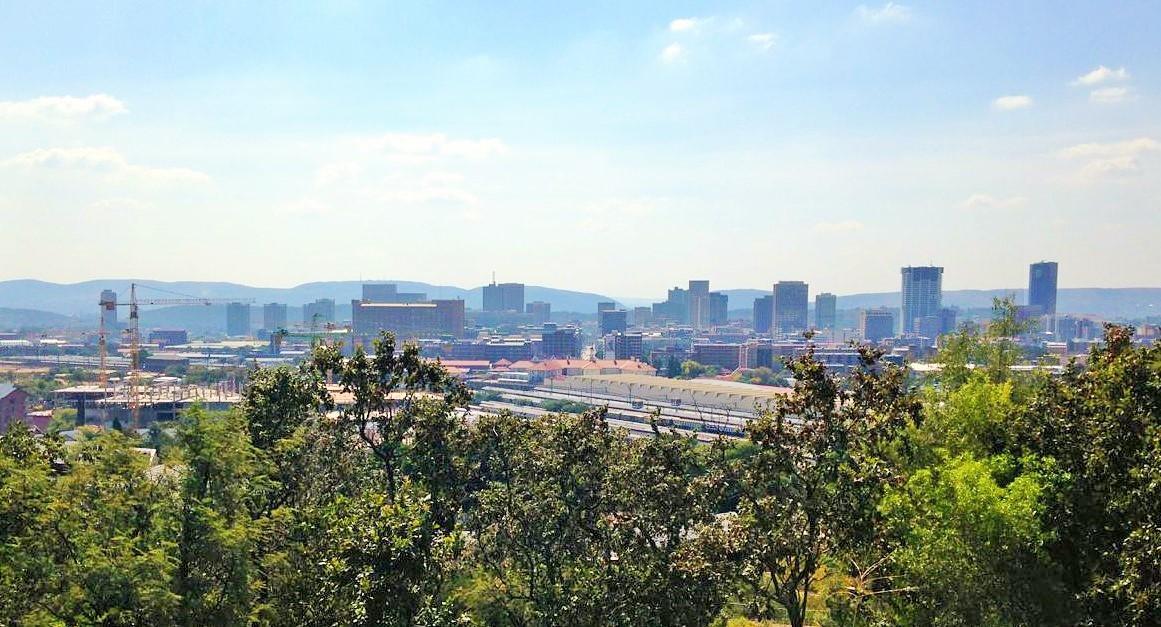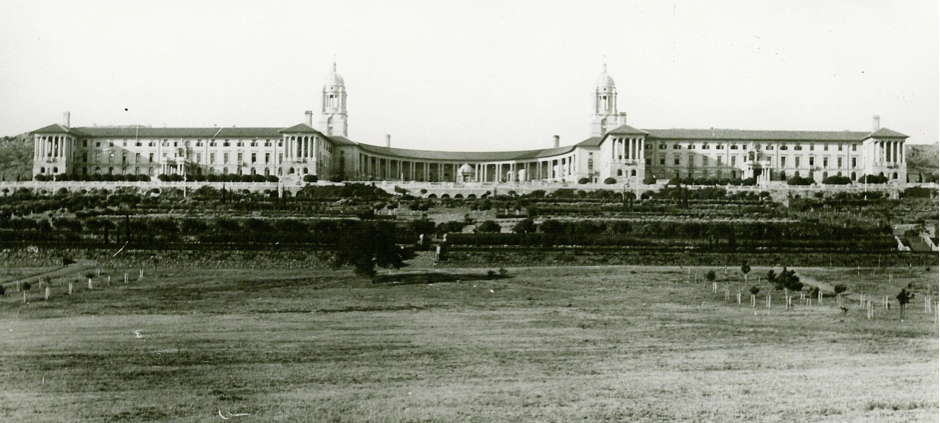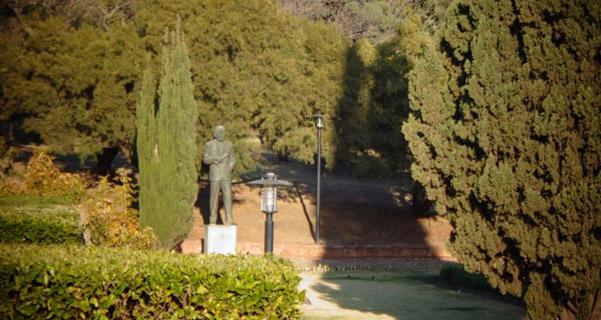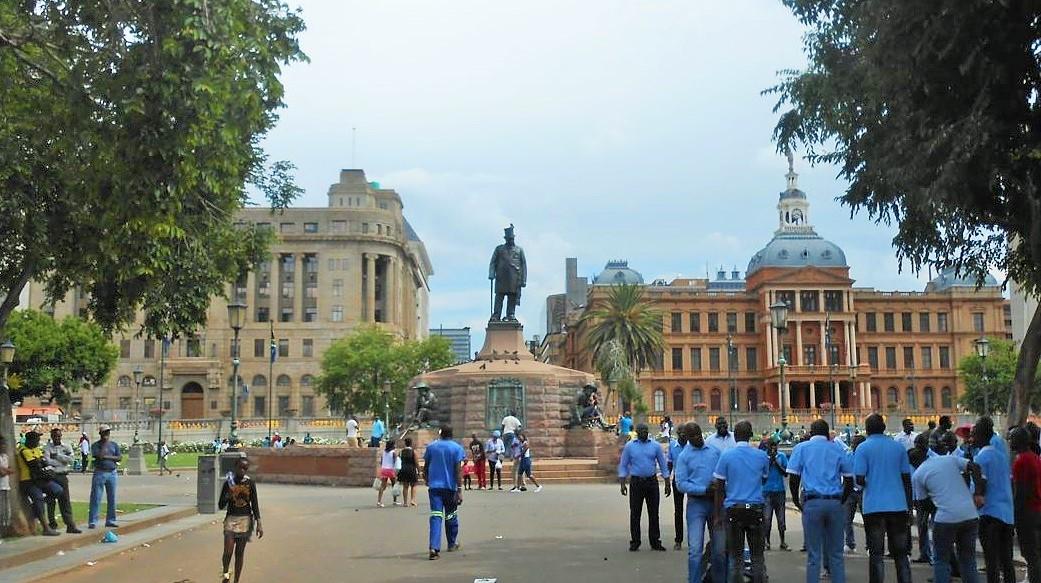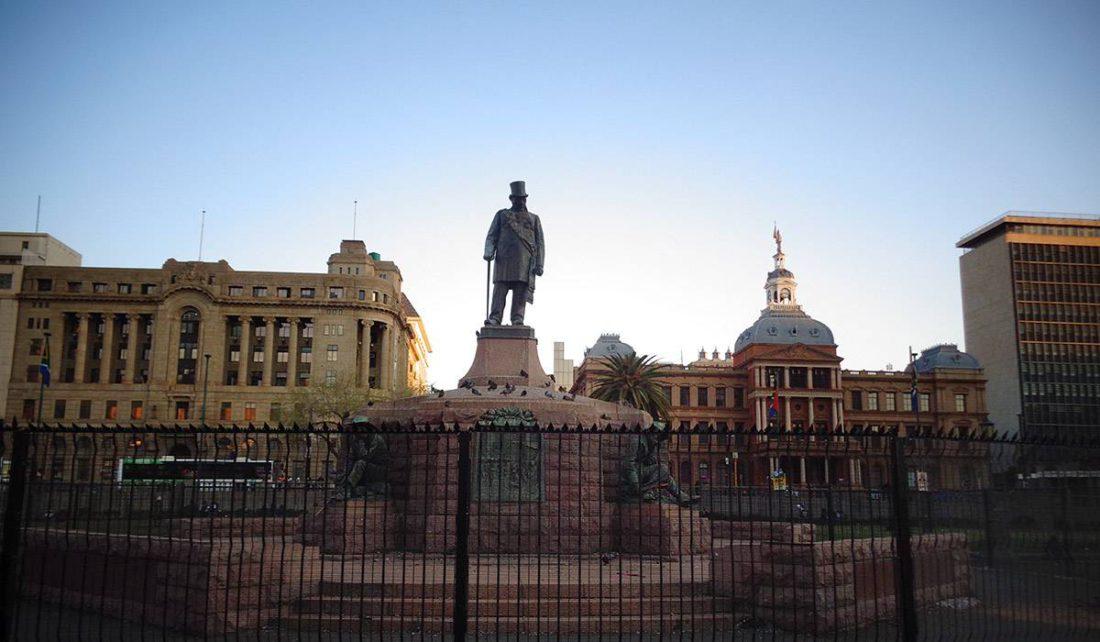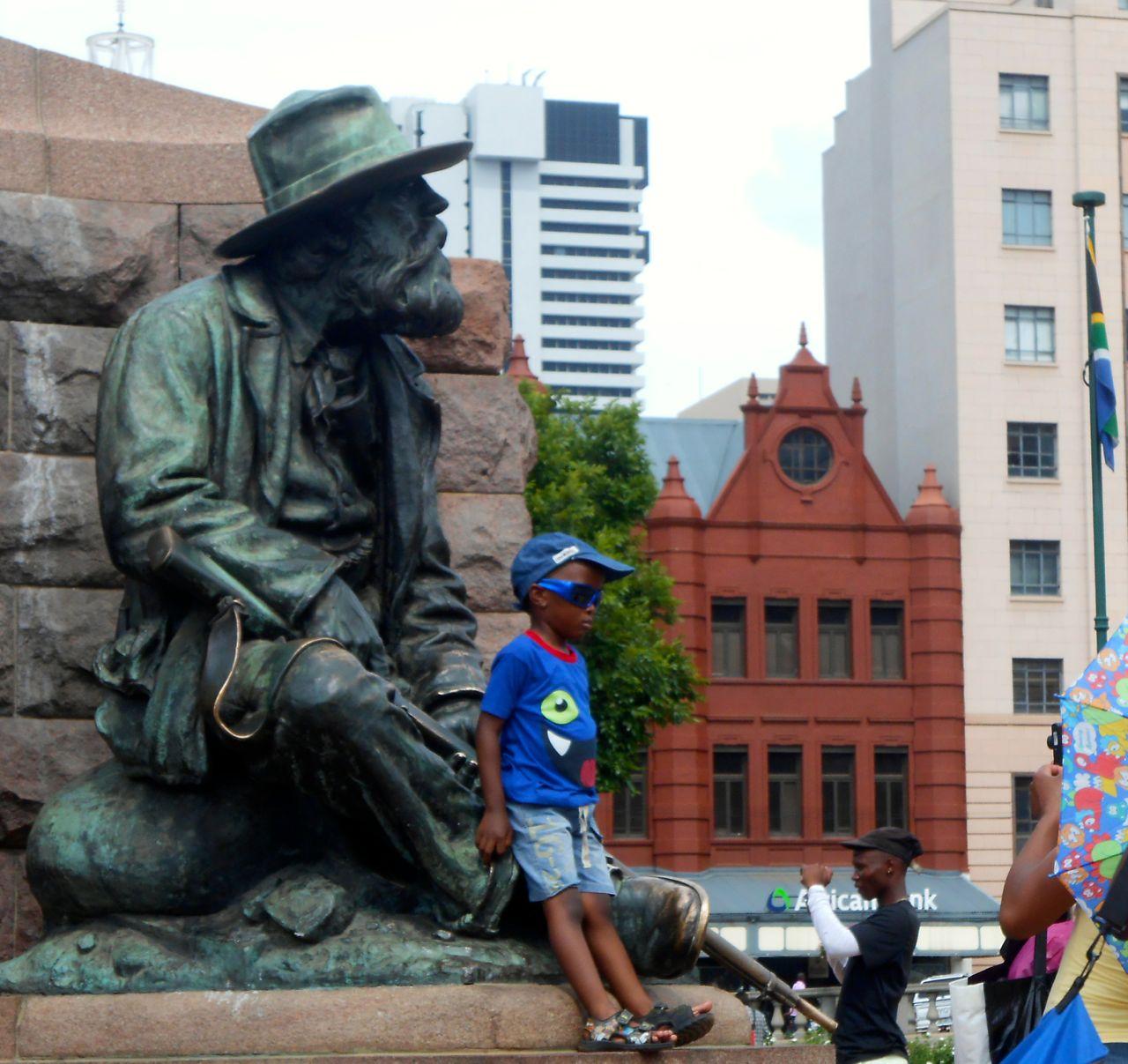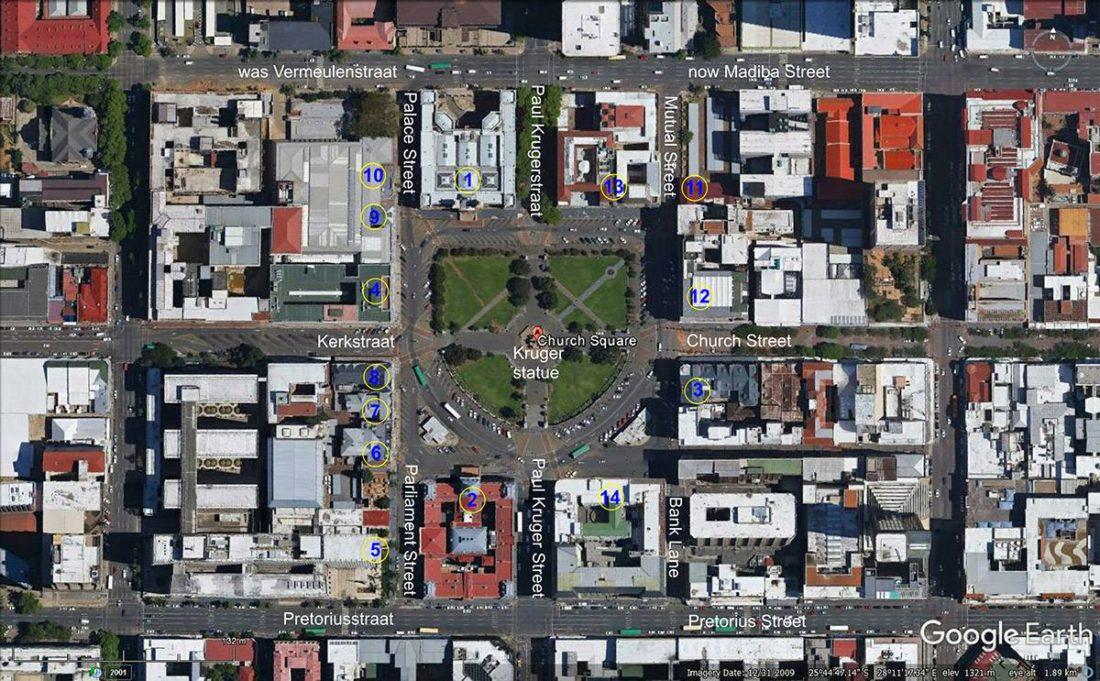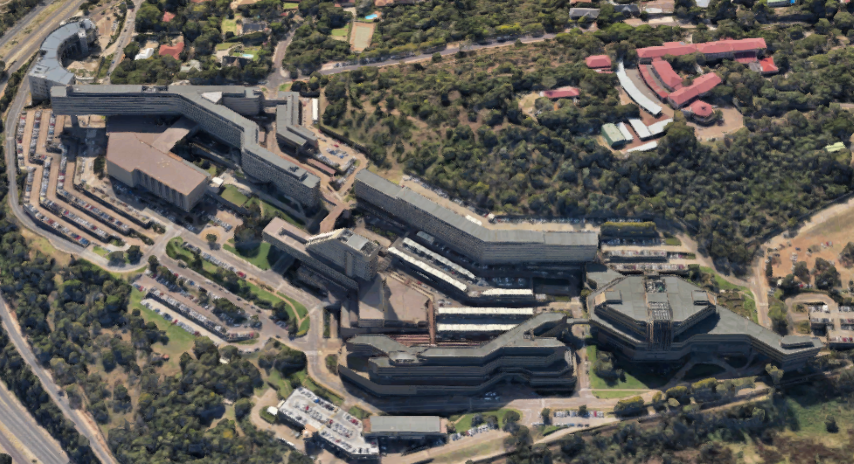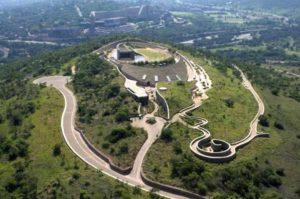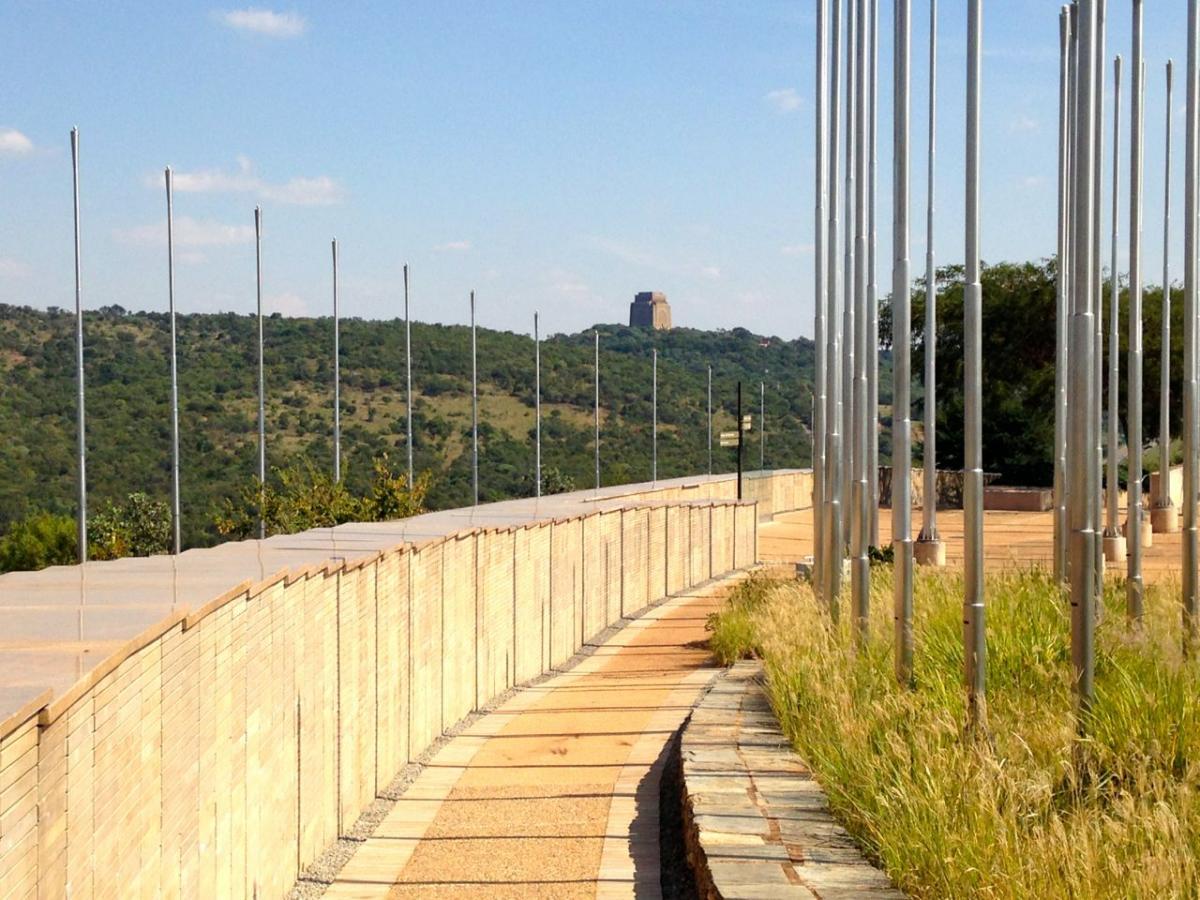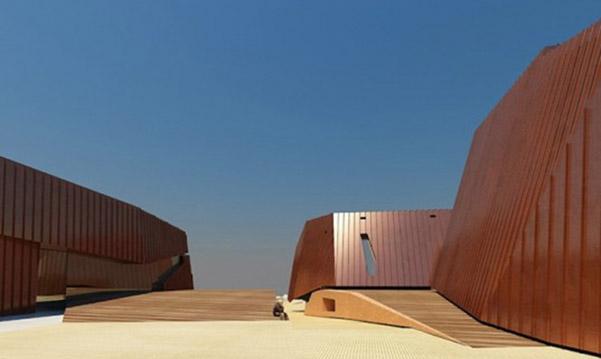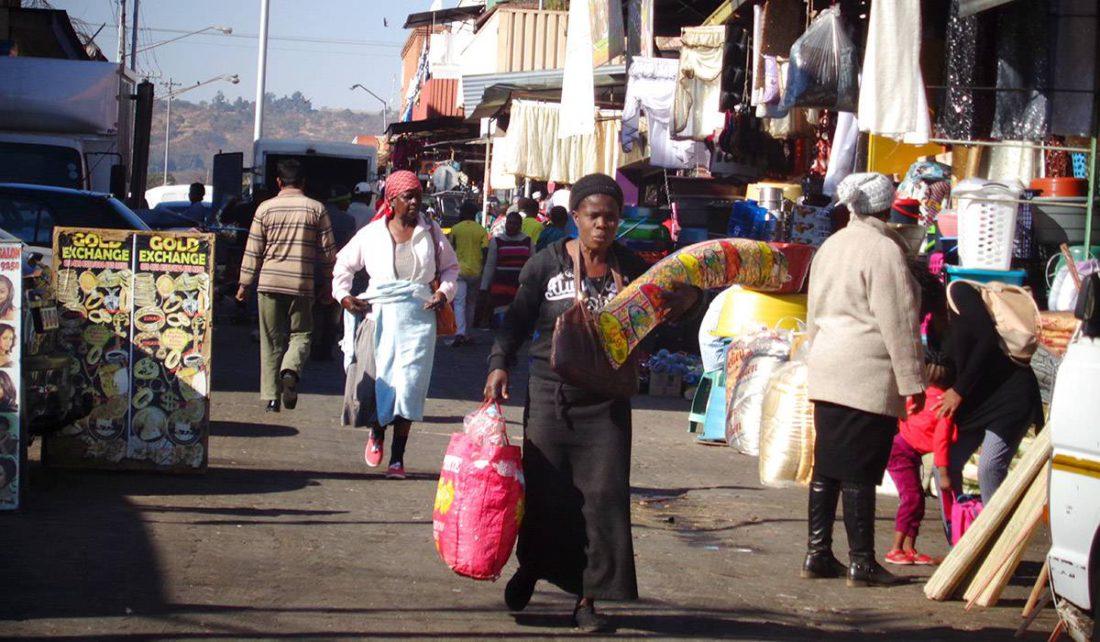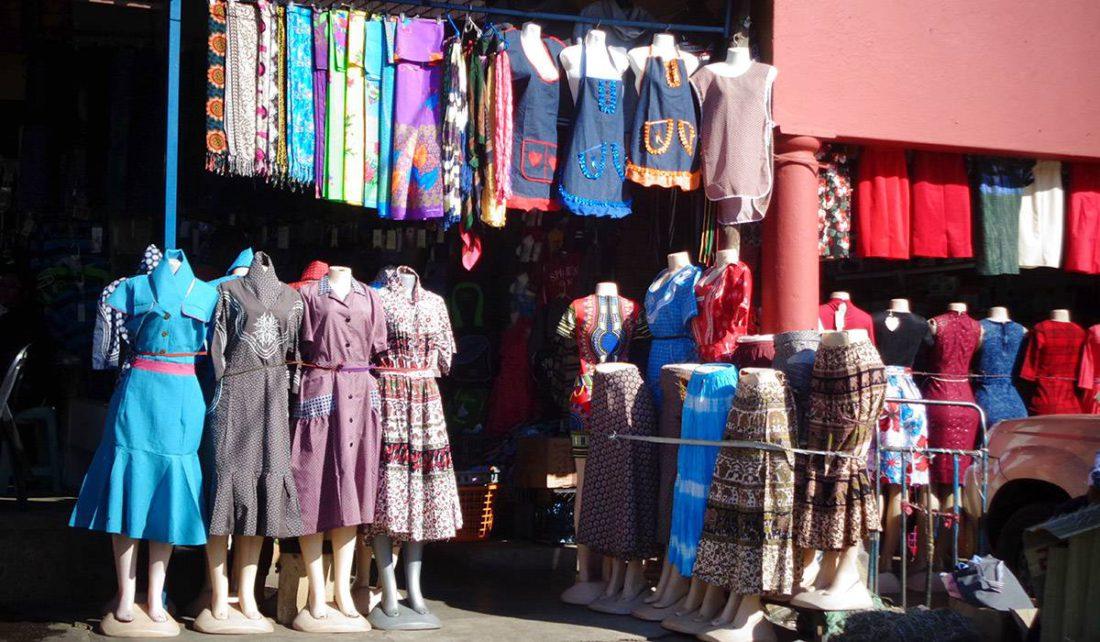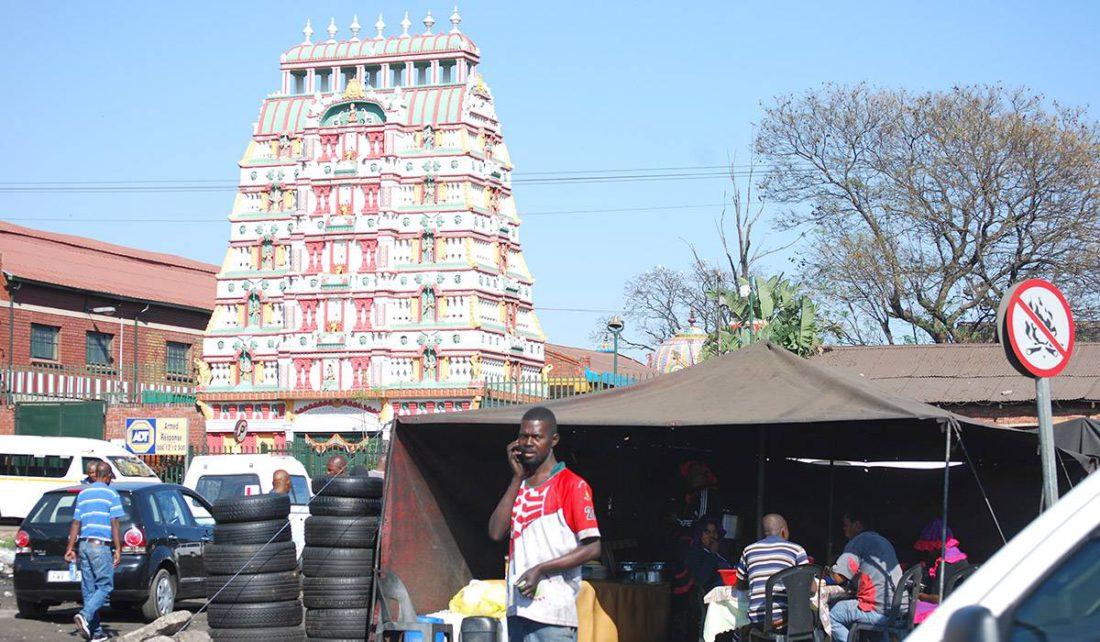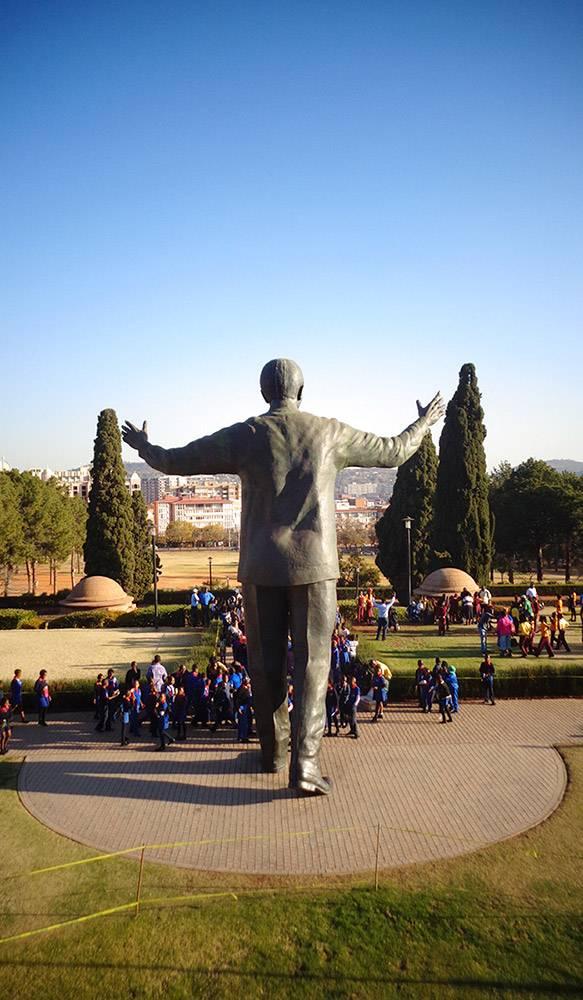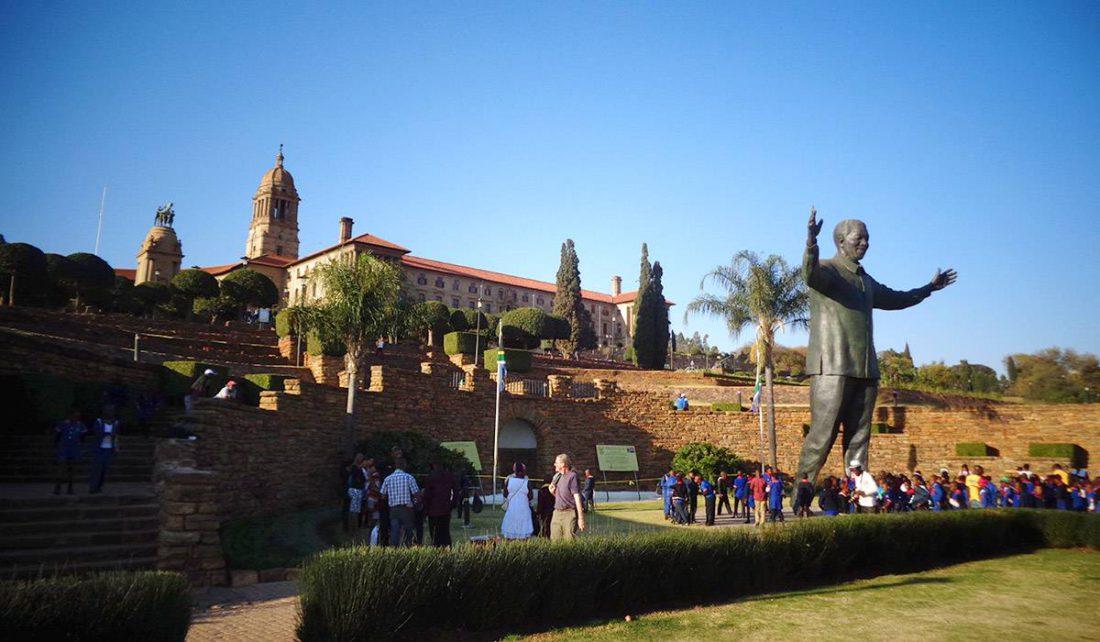
Disclaimer: Any views expressed by individuals and organisations are their own and do not in any way represent the views of The Heritage Portal. If you find any mistakes or historical inaccuracies, please contact the editor.
In the wonderful article below, Raymond Smith takes the reader on a journey to six iconic sites in Pretoria: the Union Buildings, Church Square, Unisa, Freedom Park, //hapo Museum and Marabastad. He describes the experience as a 'peripatetic walk contemplating diversity, dislocation, overlap and cohesion within an urban environment strained under its conflicting past, yet bravely attempting to respond to contemporary demands with varying degrees of success'.
A colleague from Durban and I had to travel to Tshwane/Pretoria for a workshop on Museums and Cultural Landscapes. The keynote address was delivered by Dr Webber Ndoro representing the African World Heritage Trust. His audience was members of ICOM and ICOMOS-SA and his paper observed the developments and challenges of museums in Africa and pointed out the successes and failures of the institution within the various cultural contexts. For me the most important remark he made (to a small audience) was that Africa is not a homogeneous entity and that those who refer to Africa as though one country sharing one value system are mistaken. I would like to take his comment further, by commenting that South Africa is not homogeneous and neither are the various communities within this land. This is an important observation, as to think otherwise could lead to assumptions about communities and create unfounded perceptions which polarizes a society.
My colleague (whom I shall refer to as Athos) and I landed at OR Tambo airport the day before the workshop started with the intention to explore the city after not having visited it for some time. With both of us being built environment professionals, we were keen to see how the city had evolved during the first two decades of democracy.
Pretoria Skyline (The Heritage Portal)
In our rented car, which turned out to be cheaper and more convenient than the highly acclaimed Gautrain, we headed straight for the Union Buildings (as decided in advance). The monolithic stone structure, designed by Herbert Baker in the English monumental style, remains fascinating. To what extent Baker achieved his vision ‘to resemble Acropolis City’, one can only wonder. Built on Meintjieskop, it was commissioned in 1909 with its magnificent siting commanding spectacular views over Arcadia, the city and its subjects beyond.
The Union Buildings circa 1920
The eight Million Rand new addition in front of the buildings, a 9 meters tall by 8 meters ‘wingspan’ statue of Madiba, was sculpted by Andre Prinsloo and Ruhan Janse van Vuuren. Commissioned in 2013, it took a mere four months to complete. The five times larger than life memorial statue of South Africa’s first democratically elected president was inaugurated the day after Mandela’s funeral in Qunu. Although the statue is very popular and well visited, we found the scale too inflated, arriving at the conclusion that a smaller scale would have been more fitting to remember the humble father of our democracy.
In the midst of our contemplation, surrounded by the joyful laughter of the youth surrounding us, we heard a voice calling us: “Hey white guys!” which was followed with a request to be photographed by Nigerian visitors with their friends. Not sure what to make of it, we obliged, only to realise that we were indeed the only white people around. Notions of “the other” and being observed as an object of curiosity came to mind. In hindsight I realised that this was a first for me, even though I have travelled to 14 countries on the African continent. It all occurred in good spirit with friendly acknowledgements all round, leaving one with the thought that with an unassuming attitude, one can cover great distances.
At this point we called a kindred colleague named ‘Aramis’ to find out where the Hertzog statue was moved to (it used to stand where the Mandela statue now resides). “Look east, where the trees begin,” he replied. We found it in a distance about 100 meters away along a side path on axis with the war memorials. The unimposing bronze stands about twice human scale on a concrete block with no identifying name plate. Sculpted by Coert Steynberg to memorialise James Barry Hertzog, who served as Prime Minister between 1924 and 1939. It should be noted that the decision to move and re-instate it elsewhere in the garden was subject to a consultation process – how long or extensive it was I don’t know, considering that the Madiba sculpture had to be produced within only four months.
Hertzog Statue at the Union Buildings (Raymond Smith)
Our next stop was the historic centre of Church Square which Athos placed on our itinerary for the day, insisting that it is the ‘best designed urban space in South Africa.’
Paul Kruger Statue in Church Square (The Heritage Portal)
Upon our arrival at Church Square, our colleague Aramis awaited us. Being his home town and therefore knowing his way around, it was most insightful to be escorted around Church Square and some of its prominent buildings of which the earliest dates back to the late 1800’s.
The Square was originally named Market Square with a thatched-roof church in the centre (1856 until 1905 when it burned down) which was the first church built in Pretoria. Since 1954 the central position belonged to the statue (by Anton van Wouw) of the famous Boer leader and President of the South African Republic, Paul Kruger, where it still stands today. Unfortunately, due to the recent defacement of public sculptures during student riots around the country, a temporary fence surrounds it – much to the dismay of a number of photographic service providers positioned around the statue. Apparently, most tourists to the square want to be photographed with Oom Paul. Interesting how a symbol which once ensconced a certain set of values can transcend its original purpose to be rekindled by the public in another era – albeit for sentiment or entertainment.
The Paul Kruger Statue surrounded by a fence (Raymond Smith)
Posing with one of the unnamed Boer soldiers beneath the Paul Kruger Statue before the fence (The Heritage Portal)
In 1912 the planner Vivian S.Rees-Poole was commissioned with the brief “to design a public space which would do for Pretoria what Trafalgar Square does for London and Place de la Concorde does for Paris.” The square is anchored by historically and architecturally significant sandstone buildings such as the (2) Old ZAR Council Chamber by Sytze Wierda in 1891, (1) Palace of Justice designed by Sytze Wierda in 1902 (in which the Rivonia treason trial took place during 1963 and 1964), (3) Tudor Chambers by John Ellis in 1904, and the (4) General Post Office designed by William Hawke in 1910 and the (5) Old Capital Theatre designed by PR Cook in 1931. Various banks and chambers were also built around the Square, such as the (6) Old Netherlands Bank by Wilhelm de Zwaan in 1891, (7) Regskamers by Phillip, Carmicheal & Murray in 1891, (9) Old National Bank Chambers and Mint Building by Emley & Scott and Unknown architect in 1892 & 1903, (10) Bank of Africa by TA & FRE Sladdin in 1906,(11) Eerste Volksbank by Cowin & Ellis in 1930, (12) Barclays Bank by Gordon Leith c.1930, (13) Old Reserve Bank and Old Mutual Building by Baker & Leith and Frederick McIntosh Glennie in 1930 and 1929. (14) Standard Bank by Stucke & Harrison in 1934.
Church Square via Google Earth
By the time the three of us sat down for a coffee at what used to be known as (8) Café Riche (designed by Francois Soff in 1905), on the corner of Church and Parliament Streets, it was late afternoon. We were rather exhausted after our abundant exploration and admiration of the special qualities of the environs, buildings and detail we observed and in agreement that the Square forms a strong centre which managed to contain a sense of continuum in order and stability. The tranquil atmosphere is filled with character – people passing slowly, some sitting on benches around the Square as though drawing strength from it. It is a meditation space, a space which demands contemplation. Once the power house of politics, economy and law of the country – Church Square has become a dignified space of introspection. Athos was right.
We said goodbye to Aramis and headed off to our B&B for the night.
The next morning delivered a culture shock by comparison to what we experienced the day before. We arrived at the largest University on the continent, UNISA (boasting over 300 000 enrolled students) in order to attend our workshop. The Muckleneuk Campus, situated against the Muckleneuk Ridge was opened in 1972. The original complex of buildings was designed by Bryan Sandrock Architects in the 1960’s in the International Style. I must confess that the building does nothing for me. The endless passages and walkways and sheer bulk of it all makes me think of an over-sized super yacht that somehow got stranded during a huge flood in the wake of the glacial period.
Unisa from above (google maps)
The entire experience reminded me of something Witold Rybczynski once commented on in a text by Walter Cope and John Stewardson (1900) in making a case for their proposal for a new campus for Washington University in St. Louis in which they stated: “there is a sentimental connection that exists between Gothic and institutions of higher learning, which evolved side by side in the Middle Ages,” and that “If we ignore true sentiment in architecture we shall have little left.” Rybczynski wrote: “I realized when I read this that this is precisely what disturbs me about the current fashion in architectural design. Buildings have eliminated all sentiment. They may be ingenious and complex, but they are so in a way that is hermetic and self-contained. Instead of “looking like” buildings, that is, establishing a sentimental tie with the long arc of history, they merely look forward into an unknown future. Perhaps that’s why they remind me of giant appliances” (Rybczynski, 2016).
By lunchtime, Athos and I were on our way to Freedom Park in the hope to re-establish some sense of continuum, or at least, retrace our historical trajectory.
We arrived at Salvokop and read some of the tourist information at the entrance to better understand what we were about to engage with. The slogan – “Honouring our Heroes and our Heroines.” The vision – “To be a leading national and international icon of humanity and freedom.” Mission – “To provide a pioneering and empowering heritage destination in order to mobilise for reconciliation and nation building in our country; to reflect upon our past, improving our present and building our future as a united nation; and to contribute continentally and internationally to the formation of a better human understanding among nations and people.” Values – “In carrying out its mandate, Freedom Park is committed to the following values: Tolerance of diversity, Inclusivity, Trust, Transparency and Accountability.”
Freedom Park from above with the Unisa Campus in the background (Freedom Park website)
On 52 hectares, overlooking the City of Tshwane/Pretoria, Freedom Park was constructed as a response to the Truth and Reconciliation Commission (by government) to honour those who sacrificed their lives for freedom. The publicity material states that “It also celebrates and explores the country’s diverse peoples, and our common humanity, through compelling stories, performances, exhibits and architecture.”
The Freedom Park Trust was established in 2000 to launch the constructed heritage project.
During 2003 a symbolic cleansing and reparation period ensued to acknowledge major conflicts in South Africa’s history. A nationwide project took place during these ceremonies, while trees and soil from each province were collected to be re-instated in the Garden of Remembrance surrounding Freedom Park. This Garden of Remembrance was inaugurated in 2004. Phase one of Freedom Park was completed on 27 April 2004 (Freedom Day). Freedom Park Trust was dissolved in 2009 to form Freedom Park Cultural Institution with a Department of Arts & Culture operating budget of 64 Million Rand and 97 staff members. The visitor figure adds to around 54 000 per year (Mail & Guardian, 24 April 2015).
Athos and I walked the talk and ended up sitting on the steps of the amphitheatre overlooking the water (with eternal flame) in front of the 200 seater concert hall (surrounded by almost 200 ascending metal reeds up to 32 meters high – signifying the rebirth of the nation) when Athos commented: “It is unacceptable that not all soldiers who died during the South African Freedom Struggle’s names are recorded here.” His observation took me by surprise, as I have read in official brochures that there is space for 136 000 names on the 697 meters of wall, while thus far only 75 000 names have been recorded. How ironic, I thought, considering the values that this place is meant to symbolise for our nation – another lost opportunity. It is a peaceful and tranquil space where anyone may sit and remember those who have sacrificed their lives at any point during our country’s history, not just the recent past, nameless or not.
View from Freedom Park towards Voortrekker Monument in the distance (The Heritage Portal)
At some point during the afternoon while walking around the memorial site, I thought of the book Turning Point by Fritjof Capra (1982). It examines the role of science, society and rising culture. A movie called Mindwalk (1990) was based on the book in which a scientist, poet and politician contemplates life. Then I realised, while looking back at history towards the Voortrekker Monument in the distance (designed by Gerhard Moerdijk and inaugurated in 1949) and the Union Buildings on the same axis in the opposite direction, that perhaps there is some sense to be obtained from it all. Some meaning lodged in the continuum of history, no matter how problematic and contested, which we have not yet been able to unearth.
In the Voortrekker Monument, there is also a historic hall of Heroes, housing the world’s longest marble frieze and a tapestry with over three million stiches. This monument, constructed on a 553 hectare conservation area, is managed privately as a non-profit Section 21 company with an operational cost of around sixteen Million Rand per annum and a staff compliment of 84 people. Visitor numbers are in the region of 250 000 per year (Mail & Guardian, 24 April 2015). Although regarded as a SAHRA “Grade I” Heritage Site, (and being among the top 10 most visited tourist sites in the country), it receives no funds from the Department of Arts and Culture to maintain. Having both visited the Monument some years ago, there was only time to consider it from a distance as part of the broader context this time.
Although it is true and just, that “not all history is equal in the present,” it is always important to tell the complete story in order to contextualise events, in this respect – the Reconciliation Road (stretching from the Voortrekker Monument to Freedom Park, inaugurated on 16 December 2011), links the past with the present. It was closed for some time due to management commitment issues, but fortunately re-opened in March 2016. According to Cecilia Kruger (Managing Director of the VTM and The Heritage Foundation), there exists a memorandum of understanding (signed on 15 December 2016) and working relationship between these two monuments today.
We started walking down some path on the hill, paused at a VIP drop-off zone (probably for guests to one of the various banqueting halls) and ended sitting on narrow steps lower down. We talked about our lives, our beloved country, our role in its future and how we could possibly maintain some kind of meaning and happiness amidst all the conflicting values and contestations which surrounds us.
Our next visit was to the //hapo museum which is Khoisan for “a dream”. The troublesome entry into the much acclaimed //hapo museum was disturbing. If it was the intention of GAPP with Mashabane Rose and MMA architects to confuse the visitor’s entry point, they certainly succeeded. If two built environment professionals struggled to find the path to ‘enlightenment’, I feel sorry for the general public. Don’t get me wrong – we are open to the idea of deliberately designing the entrance in such a way that it must be discovered, or experienced in a particular symbolic way, but honestly – numerous doormen with hand-held radios are actually required at various points to show the route to visually literate individuals. (We could not help but notice that we were the only visitors on this particular Friday afternoon.)
//hapo Museum (Phaidon website)
Apparently the concept for the //hapo Museum was derived from a healer’s homestead in Kuruman in the Northern Cape which led to the “big boulder-like forms which contain the museum’s storey-like forms which contain the museum’s story-telling areas.”
“With walls and roof all copper sheeting, the ‘outcrop’ will, with time, rust to green and merge with the natural landscape,” according to the architects. Inside, there is a 11000 square meters exhibition space, where artefacts from pre-colonial days to post-apartheid reconstruction will be on show. According to the museum, //hapo “will be a place for the South African community to dream dreams together and to know which dreams to follow as we invent ourselves as a society.”
Pleasing words and intentions, but I could not help thinking about the fate of the other award winning Red Location Museum in New Brighton, Port Elizabeth (designed by Noero Wolff Architects and opened in 2005) which was forced to be closed down by the community in October 2013 as a result of protests around RDP housing needs. It was re-opened in May 2016, although amidst a divided community. It should have been clear at this point, that housing is regarded as significant as memorials, statues and symbolic public structures.
//hapo certainly is a world-class facility with exhibits incorporating the latest in digital technology but lacking in human tactile experience. Personally, I found some of the spatial experience over the top and rather alienating. Missed opportunities abound – with the most obvious the large window in the exit room – which could have been a view of the Union Buildings across town (to complete the cycle of the “long walk”), if only the window was shifted a few meters to the right.
It certainly resembles Daniel Libeskind’s work, but comes across unconvincingly at times with moments of brilliance undermined by pretence during the experience. I am indeed being hyper critical, considering the symbolic importance of this project which aims to communicate to visitors where we come from, who we are and how we hope to negotiate the future as a country – if that is at all possible in a limited national narrative.
With a few hours left before our departure from OR Tambo, we decided to leave the copperclad construction and its obvious tourist-orientated top-down story telling template to rather spend more time in a place where we hoped to capture some soul. The ‘Asiatic Bazaar’, as it was proclaimed during the Apartheid era and still noted as such on Google Earth in 2017 is popularly known as Marabastad, merely 1 kilometres from the formal CBD of the City of Tshwane/Pretoria’s Church Square we visited the day before.
Marabastad Street Scene (Raymond Smith)
You would have to travel far to find such an extreme contrast in urban spatial proximity as Marabastad and Church Square. To even try and compare it with //hapo Museum and Freedom Park would be ridiculous and I doubt if these two worlds ever collide.
Marabastad Shopfront (Raymond Smith)
Mariamman Hindu temple in Marabastad, built in 1905 (Raymond Smith)
Marabastad was originally founded and ruled by the Ndebele Chief Maraba. It has become a racially diverse area not unlike District Six and Sophiatown with most inhabitants having been relocated to single-race townships further away from the city-centre during the Group Areas Act in the Apartheid era. The majority of shops are still owned by Indian businessmen with some property owned by the council and government, resulting in little development taking place.
During the Apartheid era, black residents were moved to Atteridgeville (1945), coloured inhabitants were moved to Eersterus (1963) and Indian residents to Laudium (1968).
Regardless of all the setbacks for the various communities who live, work and play here, Marabastad remains a pulsating hive with lots of soul. There has to be a way to rejuvenate the infrastructural facilities without destroying the informal character.
South Africa is indeed not a homogeneous entity and those who refer to South Africa as though one community sharing one value system are mistaken. Perhaps there is a lesson in the Madiba statue’s outstretched arms – to “embrace” diversity instead of “tolerate” it.
Mandela Statue at the Union Buildings (Raymond Smith)
I discovered unique qualities in most spaces we observed during our short visit, with each offering lessons in future urban design – some positive and some not to be repeated.
Raymond Smith was born in Welkom South Africa in 1963 and matriculated from Worcester High school in 1981. He resided in a Shona sculpture community in Zimbabwe in 1985, before pursuing his studies in Interior Design at CPUT where he obtained his National Higher Diploma in 1994. After practicing as a designer for ten years in Cape Town, his involvement in architecture resulted in him being registered as an architectural professional in 2005. Since that time he has been devoted to developing his skills in this profession. Parallel to his output in the built environment, he has also continued with sculpture/ installation projects, resulting in various collaborations and solo shows. In 2014 he obtained a Master of Philosophy degree, specialising in conservation of the built environment from UCT. Raymond is an architectural and heritage practitioner. It is the critical conversation about space-making which inspires him. Click here for more.
Comments will load below. If for any reason none appear click here for some troubleshooting tips. If you would like to post a comment and need instructions click here.

